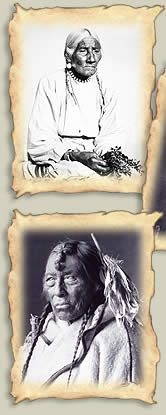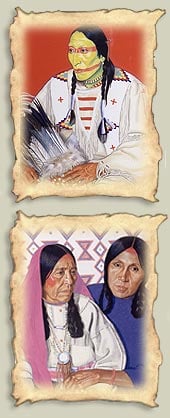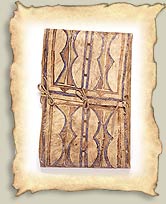|
 |
Getting Dressed
When the prayers were finished, everyone began to get dressed and move about. Our clothes were made of tanned elk skin. Men and boys wore a isttohksisoka’sim (shirt), atsis (leggings), niitsitsikin (moccasins) and iihtayo'kimao'p (a breechcloth). Women and girls wore a one-piece dress, short leggings, and moccasins.
|
 |
Isttohksisoka’sim
(man's shirt)
Collection of Glenbow Museum
Woman's Dress
Collection of Glenbow Museum
|
 |
|
 |
Going Swimming
The men took all the boys in camp to the nearest river to swim. We did this all year, even in the coldest weather. It made us strong. |
Morning Smudge
As
Iipisowaahs (Morning Star) came above the eastern horizon we began to stir in our tipis. I would lift a hot ember from the fireplace and put it onto the earth altar and then sprinkle
sipatsimo (sweetgrass) over it. As the sweet smelling smoke rose, it purified our home and our family. The men sang holy songs and prayed to encourage
Naato'si (the Sun) to rise and bring us another good day. During these prayers everyone sat quietly, thinking about the day ahead.
|
 |
|
 |
Fixing Our Hair
Our older sisters combed and braided the hair of the younger children. Our mother fixed our father's hair and then braided her own.
Our women wore their hair in two braids to reflect their modesty.
Some men wore their hair in styles that reflected family traditions or all-comrades societies. Sometimes men bundled their hair into a topknot at the front of their forehead. This indicated that he was the keeper of a Thunder Medicine Pipe Bundle.
Wearing three braids symbolizes our three nations:
Piikani (
Amsskaapipiikani and
Apatohsipiikani),
Kainai, and
Siksika. |
 |
 |
more images
Glenbow Archives NA-5425-43
Glenbow Archives NB-21-38
Glenbow Archives NB-21-4
|
|
 |
|
 |
Iiko’siiksi (Parents)
Iiko’siiksi (parents) showed their children basic life skills and were always ready with support. |
|
 |
|
 |
Painting Our Faces
Most days our faces were painted by our parents or grandparents. They usually used
a’saan (red ochre), which is like clay with iron minerals in it. They mixed the paint with bits of buffalo fat. The paint is a blessing and helps protect us throughout the day. It also acts as a sunscreen in summer and keeps our skin moist during the dry winter.
|
 |
Winhold Reiss,
Big Bull in sacred headdress, n.d.
Collection of
Glenbow Museum
Winhold Reiss.
Double Steel and Two Cutter, n.d.
Collection of
Glenbow Museum
|
 |
|
 |
Eating
The fire was stirred and brought to life. More wood was added from the pile inside our tipi. If we didn't have enough wood, our younger brothers and sisters were sent to collect more. Our mother heated a stew over the fire and passed around dry meat, berries, and
mookimaani (pemmican). The dry meat and berries were stored in
sootsimaan (rawhide containers). We all helped ourselves. There were no formal meals. People ate whenever they were hungry.
|
 |
Sootsimaan
(rawhide containers)
Collection of
Glenbow Museum
|
 |
|
|

